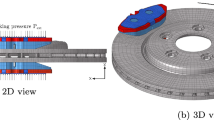Abstract
In this paper, a multibody dynamic model is developed which reflects the experimental results observed in the handrail system of an escalator. Certain model inputs such as non-linear rotational and longitudinal spring coefficients of the handrail and friction coefficient-slip ratio curve of the handrail drive are determined empirically from experimental measurements. The dynamic model effectively explains dynamic characteristics measured in the escalator with respect to various handrail tensions and retarding force. The model has been validated through comparison of experimental and simulated results such as slip ratio, power consumption and vibration of the handrail. The statistical design analysis, response surface method, is applied to determine the vital factors and their optimized levels to improve performance of the escalator. The developed model and its simulation results are used rigorously for design of the escalator handrail system.
Similar content being viewed by others
References
Kwon, Y.S. and Park, C.J., ‘Dynamic characteristics analysis of an escalator using computational dynamics program’, Proceedings of DETC98 ASME Design Engineering Technique Conference, No.DETC98/MECH-5813, 1998.
Yasumasa, H., Saito, R., and Yoshikawa, T., ‘Super high-rise escalator with a horizontal mid-section’, Proceedings of ELEVCON, Vol. 6, 1995, 78–87.
Gisper, M., Hofer, R., and Lugner, P., ‘Dynamical Tire Forces Response to Road Unevennesses’, in Tire Models for Vehicle Dynamic Analysis, Supplement to Vehicle System Dynamics, 27, 1997.
Lankarani, H.M. and Nikravesh, P.E., ‘A contact force model with hysteresis damping for impact analysis of multibody systems’, ASME Journal of Mechanical Design 112, 1990, 369–376.
Box, G.E.P. and Behnken, D.W., ‘Some new three level designs for the study of quantitative variables’, Technometrics 2, 1960, 455–475.
Khuri, A.I. and Cornell, J.A., Response Surfaces: Designs and Analyses, Marce Dekker, Inc, 1987.
Montgomery, D.C., Design and Analysis of Experiments, Third Edition, Wiley, New York, 1991.
Author information
Authors and Affiliations
Corresponding author
Rights and permissions
About this article
Cite this article
Kwon, YS., Copeland, G.S. & Park, NG. A Multibody Dynamic Model for Escalator Handrail Systems and its Application to Dynamic Characteristics. Multibody Syst Dyn 13, 253–266 (2005). https://doi.org/10.1007/s11044-005-3990-9
Received:
Accepted:
Issue Date:
DOI: https://doi.org/10.1007/s11044-005-3990-9




